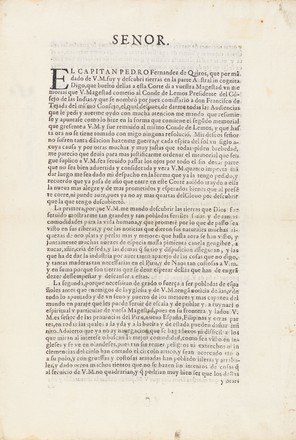A grand plan
Pedro Fernandes de Queirós was born at Evora in Porutgal in 1565. His upbringing is unclear but it seems that he was a clerk on merchant ships, eventually becoming an accomplished pilot by his early twenties. At thirty, de Queirós accepted the post of Chief Pilot on Alvaro de Mendaña’s voyage to colonise the Solomon Islands.
It was during this voyage that de Quierós gained experience in navigating the Pacific Ocean and perhaps conceived his grand plan. Having studied existing maps, he would have noted the hypothetical southern continent extending from the Strait of Magellan to New Guinea.
Austrialia del Espiritu Santo
By Sir Clements Markham, 'The Voyages of Pedro Fernandez de Quiros, 1595 to 1606', 1894
"There was a ceremony of taking possession, in the names of the Church, of the Pope, and of the King. Pedro Fernandes de Queirós took possession of all this region of the south as far as the Pole, which from this time shall be called Austrialia del Espiritu Santo, with all its dependencies for ever and so long as right exists, in the name of King Philip III. A great city was to be founded and named the New Jerusalem, and its river was to be the Jordan. All the municipal and royal officers were nominated, and a knightly order of Espiritu Santo was instituted, subject to confirmation by the King. There were processions, religious dances, high masses and fireworks".
Points in favour
In this memorial, Pedro Fernandes de Queirós makes points in favour of establishing a settlement in what he believed to be the great southern continent, mentioning the potential riches of the land: gold, silver, pearls, walnuts, cinnamon, pepper and timber; the opportunity to convert the extensive native population to Christianity before the enemies of the Church – the English and the Dutch; that possession of these lands and their conversion belongs by right to the King of Spain who could add Austrialia del Espiritu Santo to his title; that the newly discovered lands form a quarter of the world.
Quoting Luis Vaez de Torres
This memorial includes probably the earliest printed report of Luis Vaez de Torres’ voyage. Pedro Fernandes de Queirós quotes Torres’ report to King Philip III from the Philippines to support his request for another voyage. ‘He [Torres] saw a great number of islands, and navigating close to the coast line 800 leagues of land more than the ones I saw’ … ‘ten years won’t be enough to see all the land that he saw’.
Terra Australis
By Helen Wallis, ‘Did the Portuguese discover Australia?’, HistoryToday, 1988
In the sixteenth century a sixth continent featured on maps of the world, alongside Europe, Africa, Asia and the newly discovered Americas. In its most typical form this was the great southern continent, ‘Terra Australis Incognita’, which many cartographers believed had to exist to balance the large landmasses of the northern hemisphere. Classical and medieval notions of an antipodean continent encouraged the theory. Reports of discoveries by Ferdinand Magellan and others seemed, mistakenly, to confirm the continent’s existence. It was the achievement of Captain Cook in the course of his three voyages from 1768–79 to remove the main expanses of the land from the map. Leaving the possibility of an antarctic continent for further investigation. New Holland, the ‘southland’ discovered by the Dutch, was revealed as the true southern continent. The name ‘Australia’, first proposed by Matthew Flinders in 1804 as more appropriate than New Holland, commemorates the evolution of the legendary Terra Australis into the island continent of the southern hemisphere.
The Council of the Indies
By Encyclopædia Britannica
The Council of the Indies (Consejo De Indias in Spanish) was the supreme governing body of Spain’s colonies in America (1524–1834). Composed of between 6 and 10 councillors appointed by the king, the council prepared and issued all legislation governing the colonies in the king’s name, approved all important acts and expenditures by colonial officials, and acted as a court of last resort in civil suits appealed from colonial courts. It lost much of its importance in the 18th century.



 Back to list
Back to list